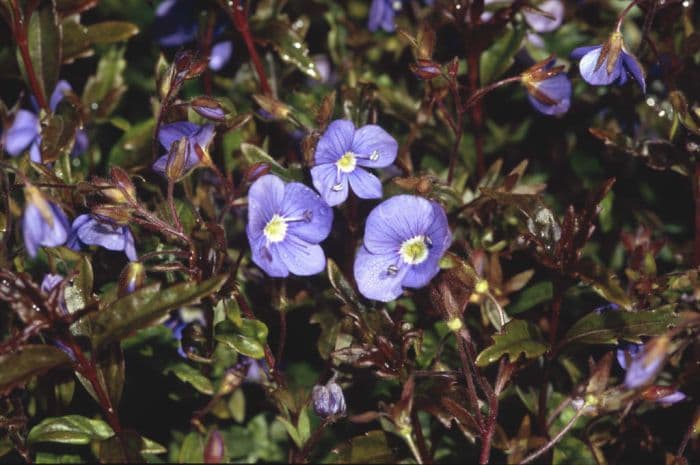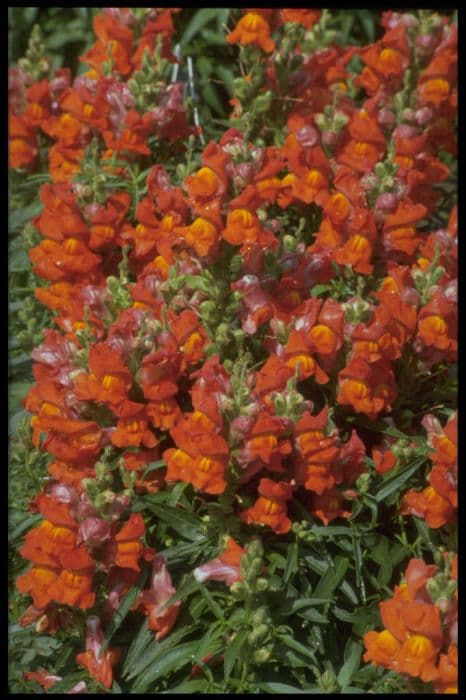Georgia Blue Speedwell Veronica umbrosa 'Georgia Blue'

ABOUT
The Veronica umbrosa 'Georgia Blue', commonly known as Speedwell, stands out with its vibrant floral display and lush, ground-covering foliage. The leaves of the Speedwell are small and finely textured, setting a dense, mat-like backdrop for its blooms. During the flowering season, it brings a burst of color with its profusion of tiny, vivid blue flowers. Each bloom adds a point of interest with its slight purple undertone and bright white centers, forming a striking contrast. The flower spikes rise just a bit above the foliage, creating a gentle undulating effect that can add visual interest to any garden space. As a ground-hugging plant, it creates a tapestry of blue that can look spectacular cascading over walls or weaving between stepping stones. Its foliage also contributes to the overall aesthetic, with leaves that may exhibit a hint of bronze during colder months, adding another dimension to the plant's year-round beauty.
About this plant
 Names
NamesFamily
Plantaginaceae
Synonyms
Georgia Blue Speedwell, Creeping Veronica, Georgia Blue Veronica
Common names
Veronica peduncularis 'Georgia Blue', Veronica 'Georgia Blue', Veronica umbrosa 'Georgia Blue'.
 Toxicity
ToxicityTo humans
Veronica 'Georgia Blue' is generally considered non-toxic to humans. There is no widespread information or reports indicating toxic effects from ingesting this plant. However, as with any plant, individual allergies and sensitivities can occur, so it's advisable to avoid ingestion and to contact a medical professional if any adverse reactions are observed.
To pets
Veronica 'Georgia Blue' is typically considered non-toxic to pets. This means that it is not known to cause any toxic effects if animals such as dogs or cats were to ingest it. Despite its non-toxic status, it's still best practice to prevent pets from consuming plants as they can sometimes cause gastrointestinal upset or allergic reactions due to individual sensitivities. If you suspect your pet has consumed a large amount of the plant and is showing signs of illness, consult your veterinarian.
 Characteristics
CharacteristicsLife cycle
Perennials
Foliage type
Semi-deciduous
Color of leaves
Green
Flower color
Blue
Height
6 inches (15 cm)
Spread
24 inches (60 cm)
Plant type
Herb
Hardiness zones
5
Native area
Caucasus
Benefits
 General Benefits
General Benefits- Attractive blooms: Georgia Blue Veronica offers vibrant blue flowers that add splashes of color to the garden in early spring.
- Groundcover: Its low, spreading habit makes it an excellent groundcover, filling in spaces and suppressing weeds.
- Drought tolerance: Once established, it is fairly drought-tolerant, reducing the need for frequent watering.
- Easy to grow: It is generally easy to care for and can thrive in a variety of soil types, as well as in full sun to partial shade.
- Cold hardy: Georgia Blue Veronica is able to withstand cold temperatures, making it suitable for many climates.
- Attracts pollinators: The flowers attract bees and butterflies, promoting biodiversity and pollination in the garden.
- Long blooming period: The plant can bloom from early spring until the first frost, providing extended visual interest.
- Low maintenance: It requires minimal upkeep beyond occasional watering and trimming back, making it ideal for busy gardeners.
- Versatile: This plant works well in rock gardens, borders, and containers, offering flexibility in garden design.
 Medical Properties
Medical PropertiesThis plant is not used for medical purposes.
 Air-purifying Qualities
Air-purifying QualitiesThis plant is not specifically known for air purifying qualities.
 Other Uses
Other Uses- Photography Backdrop: 'Georgia Blue' with its vivid blue flowers provides a beautiful natural background for close-up photography of insects and other small wildlife.
- Education Tool: Educational programs can use 'Georgia Blue' as a live example to teach botany or plant life cycle concepts to students.
- Creative Arts: Artists and crafters can press the small flowers of 'Georgia Blue' for use in making handmade paper, botanical prints, or greetings cards.
- Theme Gardens: This plant can be a charming addition to fairy or miniature-themed gardens due to its delicate foliage and sprawling habit.
- Culinary Garnish: Although not commonly consumed, the flowers can theoretically be used as an edible garnish to add color to salads or desserts, provided they are free of pesticides.
- Festive Decor: 'Georgia Blue' can be integrated into wreaths, garlands, or table arrangements for spring-themed decorations and festivities.
- Dye Production: The blue flowers might potentially be used as a natural dye source for fabrics, yarns, or other materials.
- Model Landscapes: The low growth habit makes 'Georgia Blue' suitable for use in model train or architectural landscapes as a representation of full-sized flora.
- Gift Plant: 'Georgia Blue' is a great option as a living gift due to its appealing blooms and ease of maintenance.
- Floral Arrangements: The small-scale flowers and foliage can add texture and depth to floral arrangements when used as filler material, alongside larger blooms.
Interesting Facts
 Feng Shui
Feng ShuiVeronica 'Georgia Blue' is not used in Feng Shui practice.
 Zodiac Sign Compitability
Zodiac Sign CompitabilityVeronica 'Georgia Blue' is not used in astrology practice.
 Plant Symbolism
Plant Symbolism- Hope: The delicate flowers of 'Georgia Blue' veronica can symbolize hope, representing the idea of aspirations and wishes for the future.
- Fidelity: Veronica plants, in general, have historically been associated with faithfulness, possibly due to the plant's enduring bloom.
- Healing: Named after Saint Veronica, who is said to have offered a cloth to Jesus to wipe his face as he bore the cross, the plant is often associated with compassion and the soothing of wounds, both physical and emotional.
 Water
WaterThe 'Georgia Blue' Speedwell should be watered moderately to maintain moist but well-drained soil, especially during its growing season in spring and summer. It's best to water this plant once a week, allowing the water to penetrate deeply into the soil, encouraging deep root growth. Depending on weather conditions, such as increased heat and dry spells, it may require additional watering. It's recommended to provide approximately one gallon of water weekly but be sure to adjust based on rainfall and temperature by checking the soil moisture before watering again.
 Light
Light'Georgia Blue' Speedwell thrives in full sun to partial shade conditions. Ideally, it should receive at least 6 hours of direct sunlight daily, so placing it in a spot where it gets a combination of morning sun and afternoon shade would be beneficial. If grown indoors, a south or west-facing window would be a perfect spot to ensure it gets enough light.
 Temperature
TemperatureThe 'Georgia Blue' Speedwell prefers temperate environments and can generally tolerate a wide range of temperatures, but it performs best when the temperature remains between 60°F and 75°F. It can survive minimum temperatures down to about 30°F but should be protected from frost. During extreme heat above 85°F, it may require additional care such as mulching and more frequent watering to stay cool and hydrated.
 Pruning
PruningPruning 'Georgia Blue' Speedwell is beneficial for shaping the plant, encouraging bushier growth, and removing any spent flowers to promote further blooming. It's best to prune in early spring or after the flowering season has ended to prepare it for the next growing period. Regular deadheading during the blooming season can also be done to maintain a tidy appearance and encourage new flowers.
 Cleaning
CleaningAs needed
 Soil
SoilGeorgia Blue Speedwell thrives best in well-drained soil that is rich in organic matter. A mix consisting of garden soil, compost, and coarse sand or perlite can provide good drainage and fertility. Aim for a slightly acidic to neutral pH, between 5.5 and 7.0, for optimal growth.
 Repotting
RepottingGeorgia Blue Speedwell does not require frequent repotting and it's typically every 2-3 years or when it outgrows its current container. Spring is the best time for repotting to give the plant time to establish before winter.
 Humidity & Misting
Humidity & MistingGeorgia Blue Speedwell is tolerant of a wide range of humidity conditions and does well in the average outdoor humidity. It does not have specific humidity requirements and can thrive in the ambient humidity found in most garden environments.
 Suitable locations
Suitable locationsIndoor
Place in well-lit area, avoid waterlogged soil, normal room temp.
Outdoor
Plant in sun to part shade, well-drained soil, tolerate frost.
Hardiness zone
4-8 USDA
 Life cycle
Life cycle'Georgia Blue' Veronica, also known as Speedwell, begins its life cycle when seeds germinate, usually in early spring or after the last frost. The seedlings develop into ground-hugging rosettes of leaves, and soon after, stems elongate and the first flush of small, intense blue flowers with white centers appears, signaling the vegetative and flowering stage. Throughout the spring and into summer, 'Georgia Blue' continues to bloom and grow, with the foliage spreading to form a dense mat that smothers weeds and provides a continuous cover. As fall approaches, growth slows, and the plant prepares for dormancy; the leaves may take on a reddish tinge before the onset of winter. Over winter, 'Georgia Blue' Veronica remains semi-evergreen, depending on the climate, and may retain some foliage in milder zones. With the return of warmer temperatures, the plant resumes growth, completing the cycle and ready to reproduce once again through seeding or vegetative propagation.
 Propogation
PropogationPropogation time
Spring to Early Summer
Propogation: Veronica umbrosa 'Georgia Blue', commonly known as Creeping Speedwell, is typically propagated by division, a popular method because it is simple and efficient. The best time to propagate this plant is in the early spring or early fall when the plant is not in active bloom. To propagate by division, carefully dig up an established clump and gently separate it into smaller segments, ensuring that each new piece has a portion of the root system attached. These divisions can then be immediately replanted in well-prepared soil, spaced about 12 to 15 inches (about 30 to 38 centimeters) apart to allow for growth. The newly planted divisions should be kept moist until they are well-established. By using this method, gardeners can quickly and effectively increase their Creeping Speedwell plants, creating a lovely groundcover or border in their gardens.









